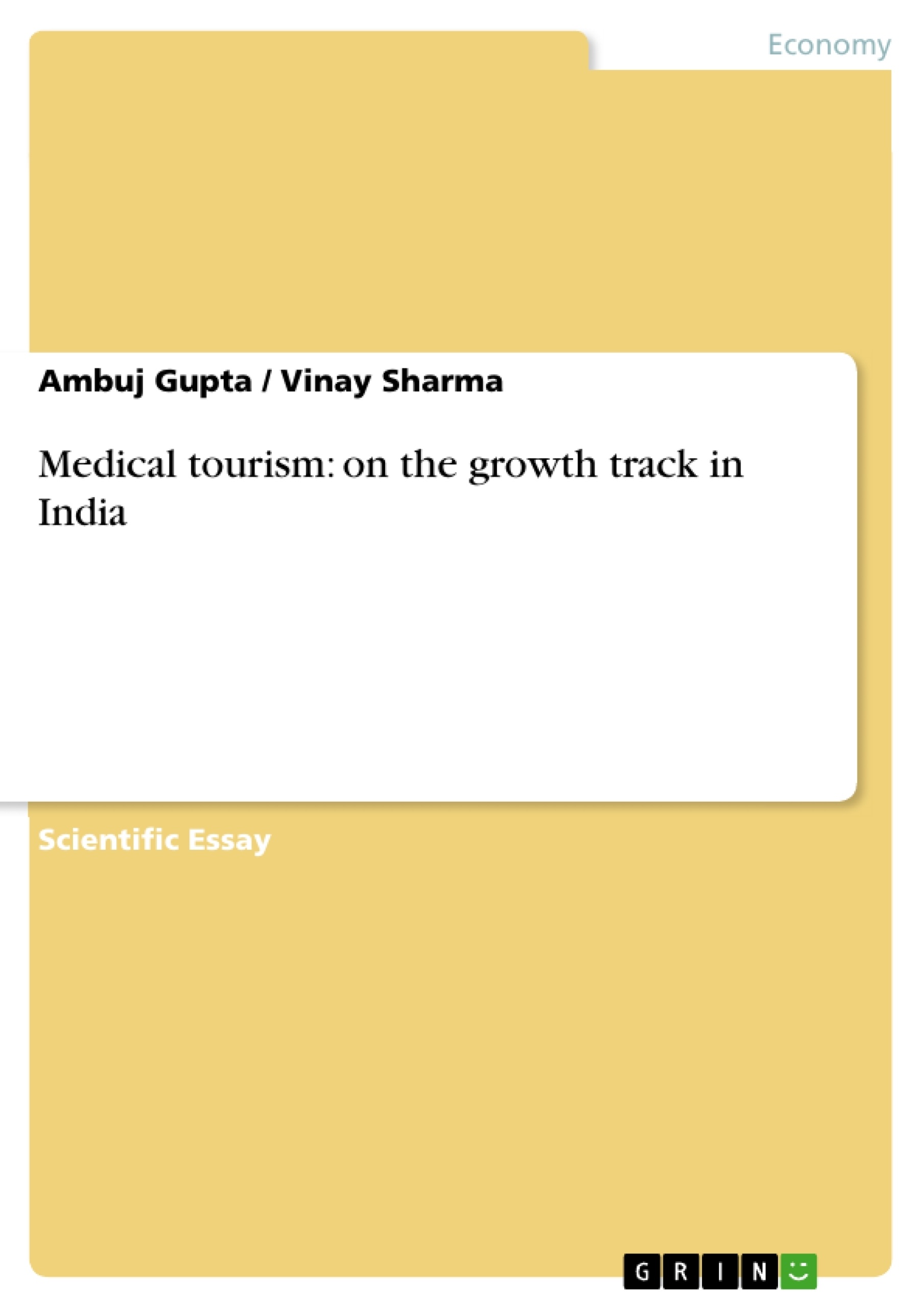
Medical tourism: on the growth track in India
Wissenschaftlicher Aufsatz, 2008
26 Seiten, Note: none
Leseprobe
Table of Contents
- Destination India: “First World Treatment at Third World Prices”
- The Competition Ahead
- Government Policy/Initiatives
- Setting Up of BPSI
- Medicities: Another Feather in the Cap
- Challenges Ahead: Workforce Related Challenges
- Leveraging and Retaining the Talent Pool
- Care for Poor
- Health Insurance: The Changing Landscape
- Standardization of Healthcare Delivery Systems
- Public Private Partnerships
Objectives and Key Themes
This text aims to analyze the burgeoning medical tourism industry in India, examining its growth drivers, challenges, and potential for future development. It explores the factors contributing to India's attractiveness as a medical tourism destination and identifies key obstacles hindering its progress.
- Cost-effectiveness of medical treatment in India
- Government policies and initiatives supporting medical tourism
- Challenges related to infrastructure, workforce, and standardization
- The role of public-private partnerships in the industry's growth
- Competition from other medical tourism destinations
Chapter Summaries
Destination India: “First World Treatment at Third World Prices”: This chapter establishes India's competitive advantage in medical tourism, highlighting the significant cost difference compared to developed nations. The text uses examples of specific procedures (liver transplant, heart surgery) to illustrate the price disparity, emphasizing the appeal of "first-world treatment at third-world prices." It also touches upon the quality of medical care and technology available in Indian hospitals, suggesting that it is comparable to Western standards. The chapter further examines the diverse patient demographics drawn to India, including Non-Resident Indians (NRIs) seeking affordable care and patients from underserved countries lacking access to quality healthcare in their home countries. It also mentions the significant number of uninsured US patients seeking treatment in India. Finally, the prevalence of cost-effective cosmetic procedures further strengthens India's position in the global medical tourism market.
The Competition Ahead: [This section is missing from the provided text and therefore cannot be summarized.]
Government Policy/Initiatives: [This section is missing from the provided text and therefore cannot be summarized.]
Setting Up of BPSI: [This section is missing from the provided text and therefore cannot be summarized.]
Medicities: Another Feather in the Cap: [This section is missing from the provided text and therefore cannot be summarized.]
Challenges Ahead: Workforce Related Challenges: [This section is missing from the provided text and therefore cannot be summarized.]
Leveraging and Retaining the Talent Pool: [This section is missing from the provided text and therefore cannot be summarized.]
Care for Poor: [This section is missing from the provided text and therefore cannot be summarized.]
Health Insurance: The Changing Landscape: [This section is missing from the provided text and therefore cannot be summarized.]
Standardization of Healthcare Delivery Systems: [This section is missing from the provided text and therefore cannot be summarized.]
Public Private Partnerships: [This section is missing from the provided text and therefore cannot be summarized.]
Keywords
Medical tourism, India, cost-effectiveness, healthcare, quality of care, medical technology, government policy, public-private partnerships, competition, challenges, workforce, infrastructure, standardization, patient demographics, NRI, cosmetic procedures.
Frequently Asked Questions: Analysis of India's Medical Tourism Industry
What is the main focus of this text?
This text analyzes the burgeoning medical tourism industry in India. It examines the factors driving its growth, the challenges it faces, and its potential for future development. The analysis includes an in-depth look at cost-effectiveness, government policies, infrastructure challenges, workforce issues, and the role of public-private partnerships.
What are the key themes explored in the text?
Key themes include the cost-effectiveness of medical treatment in India compared to developed nations, government policies and initiatives supporting medical tourism, infrastructure and workforce-related challenges, the role of public-private partnerships, and competition from other medical tourism destinations. The text also considers the care provided for the poor and the changing landscape of health insurance.
What is India's competitive advantage in medical tourism, according to the text?
India's competitive advantage lies in offering "first-world treatment at third-world prices." The text highlights the significant cost difference for procedures like liver transplants and heart surgery compared to developed countries. It also emphasizes the comparable quality of medical care and technology available in Indian hospitals.
Which patient demographics are drawn to medical tourism in India?
The text mentions Non-Resident Indians (NRIs) seeking affordable care, patients from underserved countries lacking access to quality healthcare, and a significant number of uninsured US patients seeking treatment in India.
What are some of the challenges facing India's medical tourism industry?
While the text doesn't detail specific challenges in the provided summaries, it indicates that challenges related to workforce, infrastructure, and standardization are key areas of concern. The lack of complete chapter summaries prevents a more detailed answer.
What role does government policy play in India's medical tourism sector?
The text mentions the importance of government policies and initiatives in supporting the growth of the medical tourism industry but lacks specific details due to the absence of complete chapter summaries for the relevant section.
What is the significance of public-private partnerships in this industry?
The text highlights the role of public-private partnerships in the industry's growth but lacks detailed information due to the incomplete chapter summaries.
What is the impact of health insurance on the medical tourism landscape in India?
The text mentions the "changing landscape" of health insurance as a relevant theme but lacks detailed information due to the incomplete chapter summary for that section.
What are the key words associated with this analysis?
Key words include: Medical tourism, India, cost-effectiveness, healthcare, quality of care, medical technology, government policy, public-private partnerships, competition, challenges, workforce, infrastructure, standardization, patient demographics, NRI, cosmetic procedures.
Details
- Titel
- Medical tourism: on the growth track in India
- Veranstaltung
- Business management
- Note
- none
- Autoren
- Senior Lecturer Ambuj Gupta (Autor:in), Vinay Sharma (Autor:in)
- Erscheinungsjahr
- 2008
- Seiten
- 26
- Katalognummer
- V87957
- ISBN (eBook)
- 9783638017107
- ISBN (Buch)
- 9783640827213
- Dateigröße
- 706 KB
- Sprache
- Englisch
- Anmerkungen
- Ambuj Gupta is Senior Lecturer at University of Petroleum and Energy Studies, Dehradun / Vinay Sharma is Professor at IILM-Academy of Higher Learning, Lucknow.
- Schlagworte
- Medical India Business
- Produktsicherheit
- GRIN Publishing GmbH
- Preis (Ebook)
- US$ 18,99
- Preis (Book)
- US$ 20,99
- Arbeit zitieren
- Senior Lecturer Ambuj Gupta (Autor:in), Vinay Sharma (Autor:in), 2008, Medical tourism: on the growth track in India, München, Page::Imprint:: GRINVerlagOHG, https://www.diplomarbeiten24.de/document/87957
- Autor werden
- Ihre Optionen
- Vertriebskanäle
- Premium Services
- Autorenprofil
- Textarten und Formate
- Services für Verlage, Hochschulen, Unternehmen

- © GRIN Publishing GmbH.
- Alle Inhalte urheberrechtlich geschützt. Kopieren und verbreiten untersagt.
- info@grin.com
- AGB
- Open Publishing
Der GRIN Verlag hat sich seit 1998 auf die Veröffentlichung akademischer eBooks und Bücher spezialisiert. Der GRIN Verlag steht damit als erstes Unternehmen für User Generated Quality Content. Die Verlagsseiten GRIN.com, Hausarbeiten.de und Diplomarbeiten24 bieten für Hochschullehrer, Absolventen und Studenten die ideale Plattform, wissenschaftliche Texte wie Hausarbeiten, Referate, Bachelorarbeiten, Masterarbeiten, Diplomarbeiten, Dissertationen und wissenschaftliche Aufsätze einem breiten Publikum zu präsentieren.
Kostenfreie Veröffentlichung: Hausarbeit, Bachelorarbeit, Diplomarbeit, Dissertation, Masterarbeit, Interpretation oder Referat jetzt veröffentlichen!
- GRIN Verlag GmbH
-
- Nymphenburger Str. 86
- 80636
- Munich, Deutschland
- +49 89-550559-0
- +49 89-550559-10
- info@grin.com
-









